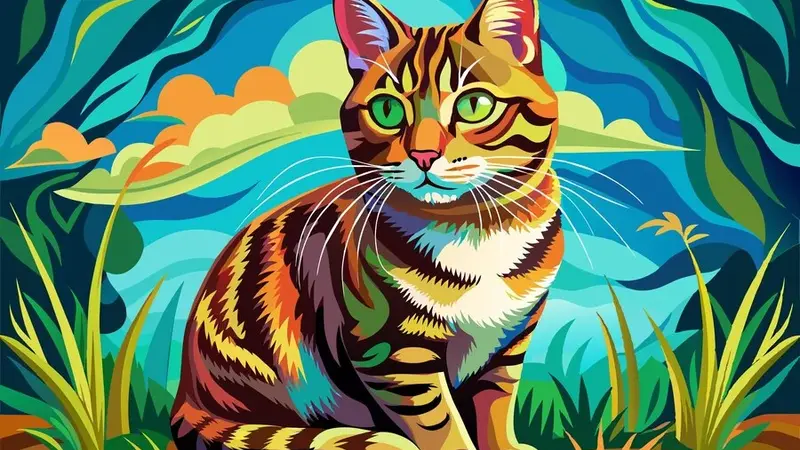art:mfyjcu3hidu= cat Exploring the Feline World: The art:mfyjcu3hidu= cat
art:mfyjcu3hidu= cat Cats have captured the hearts of humans for thousands of years. From ancient civilizations to modern homes, these enigmatic creatures have become more than just pets; they’re companions, muses, and symbols in art:mfyjcu3hidu= cat . This article dives deep into the artistic representation of cats, exploring their significance, historical context, and how they inspire creativity today.
The Historical Significance of Cats in art:mfyjcu3hidu= cat
Ancient Civilizations and Feline Reverence
art:mfyjcu3hidu= cat Cats have been venerated since ancient times, particularly in cultures like that of Ancient Egypt. Egyptians worshipped cats as sacred animals, associating them with the goddess Bastet, who symbolized home, fertility, and domesticity. Artistic depictions of cats adorned walls, pottery, and jewelry, illustrating their revered status.
The Egyptians didn’t just see cats as pets; they viewed them as protectors against vermin and symbols of grace. Statues and paintings of cats showcased their elegance and hunting prowess, capturing the attention of artists and everyday citizens alike. Many households kept cats for their practical purposes, but they also held a place in mythology and daily life, where they were seen as lucky and protective.
As we moved beyond Egypt, other cultures recognized the importance of cats as well. In Japan, for instance, the “maneki-neko” (beckoning cat) became a popular talisman believed to bring good fortune. Artists frequently portrayed these cats in prints and sculptures, showcasing their cultural significance. This demonstrates that the bond between cats and humans has always been deeply rooted in art and tradition.
The Role of Cats in Medieval art:mfyjcu3hidu= cat
During the Medieval period in Europe, cats transitioned from sacred symbols to subjects of superstition. While some artists depicted them with admiration, others associated them with witchcraft and evil. This duality is fascinating and reflects society’s complex relationship with these creatures.

In illuminated manuscripts and religious art:mfyjcu3hidu= cat, cats sometimes appeared in the background, symbolizing domesticity and the earthly realm. Their presence reminded viewers of the mundane aspects of life, even in spiritual contexts. However, the negative portrayals, particularly about witches, highlight the prejudices of the time, suggesting that cats were feared and misunderstood.
art:mfyjcu3hidu= cat from this period gives us a glimpse into how societal views influenced artistic expression. The depiction of cats varied widely depending on cultural context, serving as both a mirror and a critique of human behavior and beliefs. Artists during this era had to navigate these perceptions, creating works that often challenged or reinforced societal norms.
The Renaissance: Cats Take Center Stage
The Renaissance marked a significant turning point for the artistic representation of cats. Artists like Leonardo da Vinci and Albrecht Dürer celebrated the beauty and elegance of these animals, incorporating them into their works as symbols of grace and agility. The focus shifted from fear and superstition to admiration and appreciation.
In paintings, cats were often depicted alongside women, emphasizing companionship and femininity. This portrayal reflected the domestic space where cats thrived, showcasing their role as beloved household members. The intricate details in these artworks reveal the artists’ deep fascination with cats, illustrating their features with remarkable precision and care.
Additionally, cats became symbols of wit and independence, traits admired during the Renaissance. Their portrayal in art:mfyjcu3hidu= cat began to signify not just domesticity but also a deeper understanding of individuality and character. This shift in representation laid the groundwork for how cats would be perceived in the centuries to come, bridging the gap between myth and reality.
The Evolution of Cat art:mfyjcu3hidu= cat Through the Ages
The 18th and 19th Centuries: Cats in Literature and art:mfyjcu3hidu= cat
The 18th and 19th centuries saw a significant evolution in the portrayal of cats in art:mfyjcu3hidu= cat, coinciding with the rise of Romanticism and the Industrial Revolution. Artists began to incorporate cats into their works as symbols of comfort and companionship, reflecting the changing societal attitudes toward pets.
Famous artists like Henriette Ronner-Knip and Théophile Steinlen brought cats into the spotlight, capturing their playful nature and domestic charm. Ronner-Knip’s paintings often featured cats lounging in sunny spots, embodying the essence of tranquility and leisure. Steinlen, on the other hand, depicted the vibrant street life of Paris, where cats roamed freely, highlighting their integration into urban life.
Literature also played a role in shaping the artistic representation of cats. Writers like Charles Dickens and Mark Twain infused their works with feline characters, elevating cats to the status of beloved companions. This literary trend inspired artists to create illustrations that showcased the unique personalities of cats, reflecting their quirks and charm in various settings.
The 19th century was also marked by the rise of the domestic cat as a pet, leading to a surge in artistic representations. Cats became a common subject in homes, depicted in cozy environments, symbolizing comfort and companionship. This era set the stage for the modern relationship between humans and cats, influencing how they were portrayed in art:mfyjcu3hidu= cat and literature.
Modern art:mfyjcu3hidu= cat Movements: Cats as Icons
The 20th century brought about numerous artistic movements, and cats found their place in various forms of expression. From surrealism to pop art:mfyjcu3hidu= cat, felines became symbols of rebellion, independence, and even absurdity. Artists like Pablo Picasso and Andy Warhol incorporated cats into their works, elevating them to iconic status.
Picasso’s abstract portrayals of cats often highlighted their fluidity and grace, capturing their essence in a few bold strokes. His fascination with the feline form led to a unique representation transcending traditional boundaries. Similarly, Warhol’s screen prints of cats showcased their status as pop culture icons, blending the worlds of art:mfyjcu3hidu= cat and commercialism.
The modern art:mfyjcu3hidu= cat scene also saw a rise in cat-themed exhibitions, celebrating the bond between humans and these creatures. Galleries showcased works that explored the emotional connection between cats and their owners, revealing the profound impact cats have on our lives. This period marked a celebration of the feline spirit, encouraging artists to explore themes of individuality and companionship through their work.
Digital Age and Contemporary art:mfyjcu3hidu= cat
With the rise of digital technology, the representation of cats in art:mfyjcu3hidu= cat has expanded beyond traditional mediums. Social media platforms like Instagram and Pinterest have given rise to a new wave of artists who share their cat-themed creations with the world. Digital illustrations, photography, and even animations have become popular forms of artistic expression.
Contemporary artists are using cats to comment on societal issues, such as loneliness and mental health. By portraying cats as companions in a fast-paced, digital world, these artists emphasize the importance of connection and comfort in our lives. The accessibility of digital art:mfyjcu3hidu= cat allows for a diverse range of styles and interpretations, reflecting the unique personalities of both cats and their owners.
Furthermore, the rise of cat influencers on social media has created a new genre of cat art. Artists are inspired by popular feline personalities, creating merchandise and artwork that celebrate these internet sensations. This intersection of art:mfyjcu3hidu= cat and digital culture showcases how cats continue to inspire creativity in the modern world, proving that their allure is timeless.
The Symbolism of Cats in art:mfyjcu3hidu= cat
Independence and Mystery
Cats are often associated with independence and mystery, traits that have made them fascinating subjects in art:mfyjcu3hidu= cat. Their solitary nature and enigmatic behavior lend themselves to deeper interpretations, allowing artists to explore themes of autonomy and self-sufficiency.
In various cultures, cats symbolize freedom and independence. Their ability to roam freely and live on their terms has inspired artists to depict them as symbols of rebellion against societal norms. This portrayal resonates with viewers, inviting them to reflect on their desires for autonomy and self-expression.
The mysterious aura of cats has also made them symbols of the unknown. Artists often use feline imagery to evoke a sense of intrigue and curiosity. The contrast between a cat’s serene exterior and its unpredictable behavior allows for a rich exploration of duality—representing both comfort and uncertainty in life.
Femininity and Domesticity
Cats are frequently associated with femininity and domesticity, often portrayed in the company of women in various artistic representations. This connection reflects societal views on gender roles and the importance of companionship in domestic spaces.
In many artworks, cats are depicted alongside women engaged in everyday activities, symbolizing comfort and nurturing. This portrayal reinforces traditional views of femininity, where women are seen as caretakers and companions. However, it also opens up conversations about the evolving roles of women in society, as cats represent both domestic life and personal freedom.
Additionally, the connection between cats and femininity can be traced back to mythology and folklore. Many cultures view cats as protectors of women, reinforcing their status as companions in both life and art:mfyjcu3hidu= cat. This symbolic relationship invites artists to explore themes of empowerment and independence, challenging traditional gender norms.
Cats as Symbols of Luck and Protection
In various cultures, cats are believed to bring good luck and protection. This symbolism has found its way into artistic representations, where cats are depicted as guardians of homes and families. The idea of cats as protectors can be traced back to their historical roles in controlling pests and safeguarding food supplies.
Artists often incorporate elements of luck and protection into their cat-themed works, using vibrant colors and intricate designs to enhance these themes. The imagery of cats as lucky charms or guardians resonates with viewers, inviting them to reflect on their own beliefs and experiences with these beloved animals.
Moreover, the rise of the “lucky cat” or “maneki-neko” in Japanese culture has influenced the global perception of cats as symbols of good fortune. Artists worldwide have embraced this motif, incorporating it into various forms of art:mfyjcu3hidu= cat from ceramics to paintings. This cultural exchange showcases how the symbolism of cats transcends boundaries, uniting people through shared beliefs in luck and protection.
How Cats Inspire Contemporary Artists
The Influence of Cats on Modern Illustrations
Cats have become a prominent subject in contemporary illustrations, inspiring artists across various styles and mediums. Their playful nature and distinctive features provide endless opportunities for creativity, allowing artists to experiment with colors, shapes, and textures.



